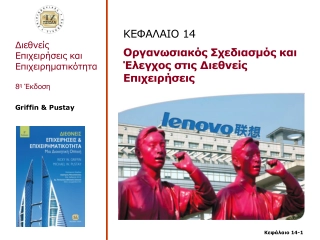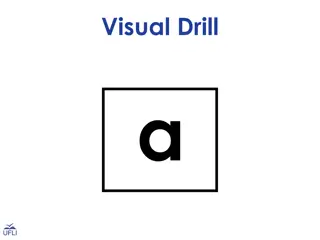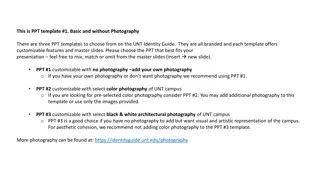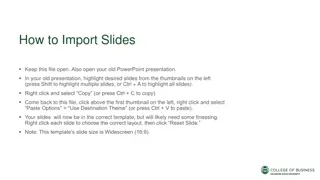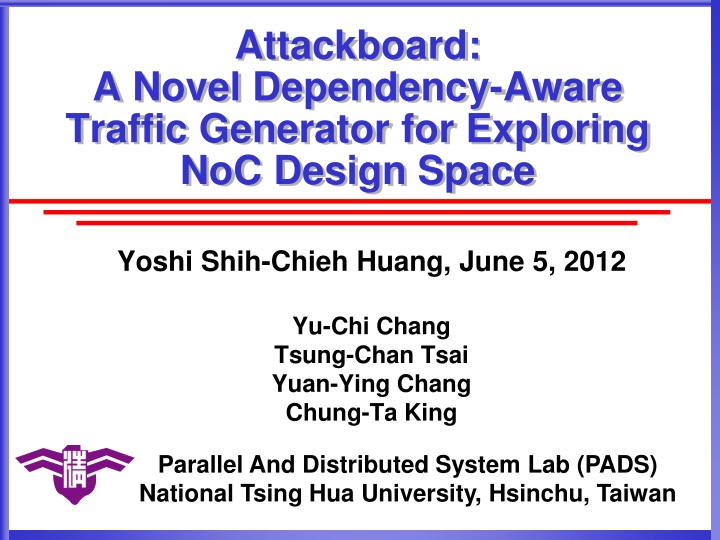
Exploring NoC Design Space with Dependency-Aware Traffic Generator
Dive into the world of network-on-chip (NoC) performance exploration for message-passing many-core architectures using trace-driven simulation. Learn how dependency-aware traces can enhance accuracy but pose challenges in terms of size, leading to innovative solutions like rebuilding state machines from traces to reduce storage overhead.
Download Presentation

Please find below an Image/Link to download the presentation.
The content on the website is provided AS IS for your information and personal use only. It may not be sold, licensed, or shared on other websites without obtaining consent from the author. If you encounter any issues during the download, it is possible that the publisher has removed the file from their server.
You are allowed to download the files provided on this website for personal or commercial use, subject to the condition that they are used lawfully. All files are the property of their respective owners.
The content on the website is provided AS IS for your information and personal use only. It may not be sold, licensed, or shared on other websites without obtaining consent from the author.
E N D
Presentation Transcript
Attackboard: A Novel Dependency-Aware Traffic Generator for Exploring NoC Design Space Yoshi Shih-Chieh Huang, June 5, 2012 Yu-Chi Chang Tsung-Chan Tsai Yuan-Ying Chang Chung-Ta King Parallel And Distributed System Lab (PADS) National Tsing Hua University, Hsinchu, Taiwan
Problem Domain 2 We want to use trace-driven simulation to explore network-on- chip (NoC) performance for message-passing many-core architecture Traces that record only send/receive events: Simple and fast Lacks information about interaction between NoC and PEs Unable to reflect the effects of changes in design space Storage space overhead (in terms of gigabytes) Recent dependency-aware traces: [1][2] Packet dependencies are embedded in traces Packet injections can be adjusted based on dependencies when facing different NoC configurations Trace logs are very complicated and require much more space Traces with packet dependencies improve accuracy but require more storage space!
The BIG Problem Is: Size! 3 How to reduce size of dependency-aware traces while maintaining its accuracy? Lossless compression, e.g., Gzip? not enough Key insight: Each PE has its own BIG trace for NoC operations Each BIG trace is actually a log of the execution of the corresponding State Machine 10 KB codes may result in 1GB traces! . ... . . . . . . S1 S1 S2 Sn S2 Sn S1 S2 Sn
Rebuild the State Machines 4 What if we can rebuild the interacting state machines from the traces ? We don t have to record the huge traces but only need to generate them at runtime! How to do? Intuitive idea: find repetitive patterns in traces and fold them Difficulties: May not be matched exactly May be discrete and fragmented in traces Need to find patterns across the traces resulted by different PEs
Rebuild the State Machines (contd) 5 State transitions in state machines are often triggered by arrivals of packets Leverage packet dep. information in traces Forget about time sequencing in traces How long to wait before start detecting receiving pattern? interval-based Interval I for capturing receiving patterns Captured results are attackboards Interval I for reproducing traffic For driving the attackboards PEj I
Data Structure of an Attackboard 6 Each PE has an attackboard An injection Y is allowed if the necessary conditions are satisfied Necessary conditions = predecessors = must receive packets from X Inject if satisfied necessary conditions Requires pkt from 1? Yes Requires pkt from 2? Yes Requires pkt from 3? No Requires pkt from X? Inject to Dest. Y
Attackboard Traffic Generator 7 1. Rebuild the state machines as attackboards Use packet arrival patterns in traces to rebuild the state machine Space complexity: O(execution time) O(# of patterns) 2. Compact the states Merge duplicated patterns 3. Drive the state machines, i.e., attackboard Inject traffic based on the rebuilt machine
An Illustration (Viewpoint of PE 4) 8 Parallel Program Execution Attackboard entries of PE 4 PE 2 PE 3 PE 4 PE 1 Packets Dependencies Injection Info. Interval I recv 1 recv 2 1 1 0 0 (3, flit counts) Packets Dependencies Injection Info. send 1 1 1 0 0 (3, flit counts) How long to wait before start Packets Dependencies detecting receiving pattern? Interval I decides the pattern! Execution flow of parallel program Injection Info. Interval I recv 3 recv 4 1 1 0 0 (3, flit counts) send 2 recv 5 recv 6 recv 7 Packets Dependencies Injection Info. recv 5 recv 6 recv 7 send 3 send 3 Interval I Interval I 1 1 1 0 (2, flit counts) Compress the entries with the same packet dependencies Merge duplicated entries
Driving the Attackboards! 9 Attackboard Traffic Generator (ATG) Traffic generation with Attackboard Attackboard of PE4 Router receives stats are cleared every I interval ATG 1 1 0 0 Match! traffic current receive source Inject! What if no exact match in I ? Match the entry which has the highest similarity Similar to bloom filter (deny for sure, allow with high confidence) router receive status of PE4 Router 0 0 0 0 1 0 0 0 1 1 0 0 Design details are left in the poster. You are welcome to take a look! NoC
Space Overhead and Accuracy 10 Storage Space Overhead IMB-Bcast Simulation Platform POD (2 frames) Processor element Tilera TILE64 1 Processor frequency 700 Mhz Simulated topology 4 4 mesh network Routing algorithm Dimension-order Bandwidth 1 flit/cycle per port 20% storage space can be reduced in computation- intensive benchmark! Storage space can be greatly reduced! Benchmark Intel MPI Benchmarks Parallel Object Detection Parallel Object Detection IMB-Bcast 4 1.3 Average network delay (normalized) Average network delay (normalized) 3.5 1.2 Dependency extraction interval I Dependency extraction interval I 3 1.1 2.5 1 2 0.9 100 100 1000 1.5 0.8 10K 5000 In this case, I does not have much impact compared with POD. 1 0.7 10000 15K I and I should be properly selected to give 0.5 0.6 0 0.5 800 900 10001100120013001400150016001700 accurate results 1200 1210 1220 1230 1240 1250 1260 1270 1280 1290 Interval of traffic generation (I') Interval of traffic generation (I') 1 S.Bell et al.[ISSCC 2008]
Conclusion & Future Works 11 Attackboard not only compresses the NoC traces, but generates them at runtime Key ideas: Programs raw trace logs use arrival patterns to rebuild state machine (as Attackboards) rebuild trace logs Benefits Strikes a good tradeoff between accuracy and space overhead Limitations Currently only for message-passing programs Only suitable for injections with strong dependencies Future works Take the computation time before an injection into consideration Make the tricky parameters (I and I ) disappeared
Thank You! To learn more, please come to my poster!
Selected References 1. Netrace: dependency-driven trace-based network-on-chip simulation. Joel Hestness, Boris Grot, and Stephen W. Keckler. 2010. In Proceedings of the Third International Workshop on Network on Chip Architectures (NoCArc '10) 2. Inferring packet dependencies to improve trace based simulation of on-chip networks. Christopher Nitta, Matthew Farrens, Kevin Macdonald, and Venkatesh Akella. 2011. In Proceedings of the Fifth ACM/IEEE International Symposium on Networks-on-Chip (NOCS '11)
Backup: More Frames in POD 10000000 1000000 100000 Size (bytes) 10000 Trace logs Attackboard 1000 100 10 1 # of frames 2 50 100 1000 Trace logs Attackboard O(execution time) O(# of patterns)


